Formula C2H2Cl2O2 Molar mass 128.94 g/mol IUPAC ID Dichloroacetic acid Appearance Colorless liquid | Boiling point 194 °C Density 1.56 g/cm³ Melting point 9 °C | |
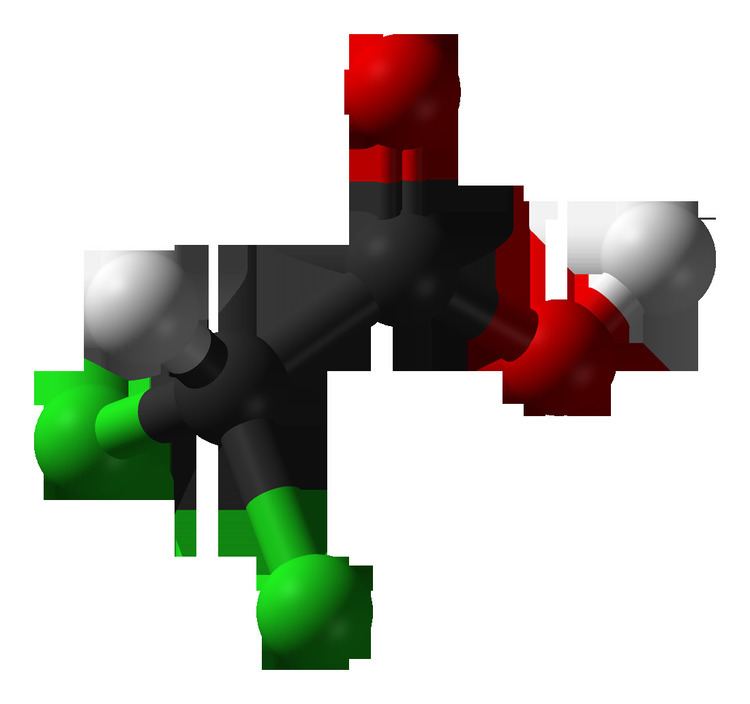 | ||
Related compounds | ||
Dichloroacetic acid (DCA), sometimes called bichloroacetic acid (BCA), is the chemical compound with formula CHCl
2COOH. It is an acid, an analogue of acetic acid, in which 2 of the 3 hydrogen atoms of the methyl group have been replaced by chlorine atoms. Like the other chloroacetic acids, it has various practical applications. The salts and esters of dichloroacetic acid are called dichloroacetates. Salts of DCA have been studied as potential drugs because they inhibit the enzyme pyruvate dehydrogenase kinase.
Contents
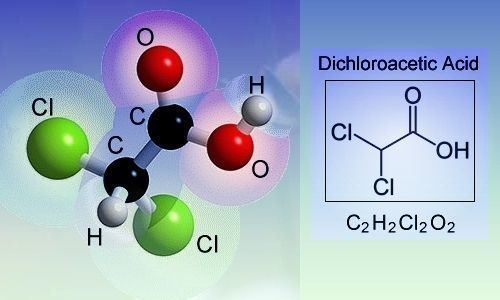
Although preliminary studies have shown DCA can slow the growth of certain tumors in animal studies and in vitro studies, as of 2012 there is insufficient evidence to support the use of DCA for cancer treatment.
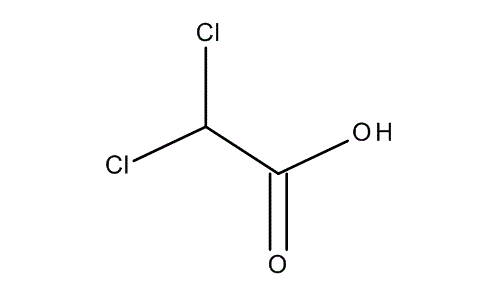
Chemistry and occurrence
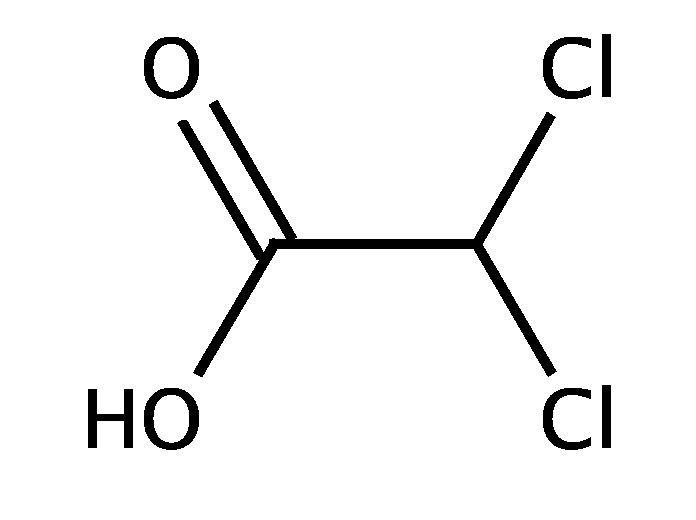
The chemistry of dichloroacetic acid is typical for halogenated organic acids. It is a member of the chloroacetic acids family. The dichloroacetate ion is produced when the acid is mixed with water. As an acid with a pKa of 1.35, pure dichloroacetic acid is classed as a strong organic acid; it is very corrosive and extremely destructive to tissues of the mucous membranes and upper respiratory tract via inhalation.
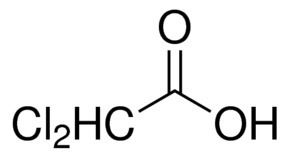
DCA has been shown to occur in nature in at least one seaweed, Asparagopsis taxiformis. It is a trace product of the chlorination of drinking water and is produced by the metabolism of various chlorine-containing drugs or chemicals. DCA is typically prepared by the reduction of trichloroacetic acid (TCA). DCA is prepared from chloral hydrate also by the reaction with calcium carbonate and sodium cyanide in water followed by acidifying with hydrochloric acid.

As a laboratory reagent, both DCA and TCA are used as precipitants to prompt macromolecules such as proteins to precipitate out of solution.
Topical chemoablation
Both DCA and TCA are used for cosmetic treatments (such as chemical peels and tattoo removal) and as topical medication for the chemoablation of warts, including genital warts. It can kill normal cells as well.
Lactic acidosis
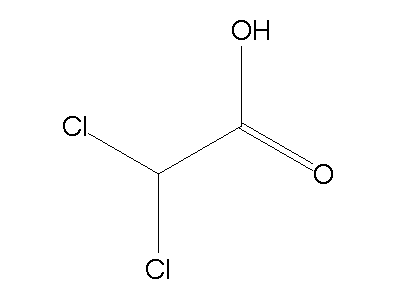
A randomized controlled trial in children with congenital lactic acidosis found that while DCA was well tolerated, it was ineffective in improving clinical outcomes. A separate trial of DCA in children with MELAS (a syndrome of inadequate mitochondrial function, leading to lactic acidosis) was halted early, as all 15 of the children receiving DCA experienced significant nerve toxicity without any evidence of benefit from the medication. A randomized controlled trial of DCA in adults with lactic acidosis found that while DCA lowered blood lactate levels, it had no clinical benefit and did not improve hemodynamics or survival.
Thus, while early case reports and pre-clinical data suggested that DCA might be effective for lactic acidosis, subsequent controlled trials have found no clinical benefit of DCA in this setting. In addition, clinical trial subjects were incapable of continuing on DCA as a study medication owing to progressive toxicities.
Cancer
Although preliminary studies have shown DCA can slow the growth of certain tumors in animal studies and in vitro studies, the American Cancer Society stated that "available evidence does not support the use of DCA for cancer treatment at this time [2012]." Physicians warned of potential problems if people attempt to try DCA outside a controlled clinical trial. "If it starts going badly, who is following you before it gets out of control? By the time you realize your liver is failing, you're in big trouble", said Laura Shanner, Associate Professor of Health Ethics at the University of Alberta. Notably, at least one fraudster, Hazim Gaber, has been convicted and sentenced to 33 months in prison for selling fake DCA to cancer sufferers.
The only monitored in vivo dosage of five human patients suffering from glioblastoma with DCA was not designed to test its efficacy against their cancer. This study was rather to see whether it could be given at a specific dosage safely without causing side effects (e.g. neuropathy). All five patients were receiving other treatments during the study. Observations in vitro and of tumours extracted from those five patients suggest that DCA might act against cancer cells by depolarising abnormal mitochondria found in glioblastoma cancer cells – allowing the mitochondria to induce apoptosis (cell death) of the malignant cells. However, in vitro work with DCA on neuroblastomas (which have fewer recognised mitochondrial abnormalities) also showed some activity against very malignant, undifferentiated cells. A recent case report discusses and reviews the potential application of DCA in central nervous system malignancies.
Neuropathy
Neuropathy has been a problem in some clinical trials with DCA causing them to be effectively halted, but a review found that it has not occurred in DCA other trials. The mechanism of DCA induced neuropathy is not well understood. On the one hand in vitro work with nerves has suggested a mechanism for the neuropathic effect of DCA; with DCA showing a dose and exposure dependent demyelination of nerves (stripping of the nerve 'sheath'), which demyelination was partially reversible over time, following washout of DCA. On the other hand, a review in BJC states "This neurotoxicity resembled the pattern of length-dependent, axonal, sensorimotor polyneuropathy without demyelination." with regard to the 2006 study by Kaufman et al.
Heart failure
DCA has been investigated as a treatment for post-ischemic recovery. There is also evidence that DCA improves metabolism by NADH production stimulation, but may lead to a depletion of NADH in normoxia.
